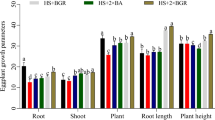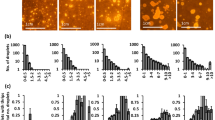Abstract
A series of experiments were conducted in which label rate (0.3 g per kg of wheat) with diatomaceous earth (DE) formulation Protect-It. Exposure studies were carried out at two levels of relative humiditiy (40% and 55%), two levels of insect density (10 or 20 adults per vial), and three levels of exposure periods. Test insects were placed in vials containing 40 g of soft white winter wheat mixed with either 0 or 0.3 g Protect-It per kg of wheat. After relating exposure periods for both insect density and relative humidity levels, highest mortality was only 16%. Mortality, regardless of the dose rate applied (0 and 0.3 g) were not significantly increased as the exposure period increased. Regardless of relative humidity (r.h.) (40% and 55%r.h.), mortality in control were not significantly increased as the exposure period increased for the same insect density. However, significant differences among the three exposure periods in 10 adults’ density in 0.3 g DE application. Mortality was significantly increased in 10 adults’ density. In this case mortality of R. dominica adults increased with the increasing of the exposure intervals. As for 20 adults’ density, mortality in 0.3 g DE application was not significantly changed along with the exposure intervals. After insects were exposed for 1, 2, or 3 week, dead and live insects were removed, and the wheat in the vial were returned to relating humidity box and kept for 8 week until F1 adults emerged. Then, the number of F1 adult was counted. The mean numbers of F1 adults on untreated wheat at all density and r.h. combinations, regardless of exposure periods were significantly higher than that of 0.3 g DE- treated wheat (Fig. 3). At each density and treatment, the mean number of F1 adults at 55% r.h. were higher that that of 40%r.h. The comparison between adult densities at each r.h. and treatment showed that adult densities influenced the F1 production of R. dominica and F1 adults were always higher at 20 adults’ density. The mean number of F1 adults at each density, regardless of treatment progressively increased as the exposure period increased. Fewer progeny were produced at 10 adults’ density compared to 20 adults’ density for same exposure periods. The highest reproduction occurred in 3 week of exposure period for both insect densities. Regardless of adult densities, the mean number of F1 adults was significantly increased as the exposure period increased (Fig. 5) for both control and 0.3 g DE treatment. Reduction of F1 adults at 0.3 g DE application compared to control were found to be 76.88, 74.78 and 67.63% for 1, 2 and 3 week of exposure period, respectively.





Similar content being viewed by others
References
Aldryhim YN (1993) Combination of classes of wheat and environmental factors affecting the efficacy of amorphous silica dust, Dryacide, against Rhyzopertha dominica (F.). J Stored Prod Res 29:271–275
Arthur FH (1996) Grain protectants: current status and prospects for the future. J Stored Prod Res 32:293–302
Arthur FH (2000) Toxicity of diatomaceous earth to red four beetles and confused four beetles (Coleoptera: Tenebrionidae): effects of temperature and relative humidity. J Econ Entomol 93:526–532
Arthur FH (2002) Survival of Sitophilus oryzae (L.) on wheat treated with diatomaceous earth: impact of biological and environmental parameters on product efficacy. J Stored Prod Res 38:305–313
Arthur FH (2004) Evaluation of methoprene alone and in combination with diatomaceous earth to control Rhyzopertha dominica (Coleoptera: Bostrichidae) on stored wheat. J Stored Prod Res 40:485–498
Athanassiou CG, Kavallieratos NG, Tsaganou FC, Vayias BJ, Dimizas CB, Buchelos CTH (2003) Effect of grain type on the insecticidal efficacy of SilicoSec against Sitophilus oryzae (L.) (Coleoptera: Curculionidae). Crop Prot 22:1141–1147
Banks JH, Fields PG (1995) Physical methods for insect control in stored-grain ecosystems. In: Jayas DS, White NDG, Muir WE (eds) Stored-grain ecosystems. Marcel Dekker, New York, pp 353–409
Desmarchelier JM, Dines JC (1987) Dryacide treatment of stored wheat: its efficacy against insects, and after processing. Aust J Exp Agric 27:309–312
Ebeling W (1971) Sorptive dust for pest control. Ann Rev Entomol 16:123–158
Fields PG, Korunic Z (2000) The effect of grain moisture content and temperature on the efficacy of diatomaceous earths from different geographical locations against stored-product beetles. J Stored Prod Res 36:1–13
Golob P (1997) Current status and future perspectives for inert dusts for control of stored product insects. J Stored Prod Res 33:69–79
Greenspan L (1977) Humidity fixed points of binary saturated aqueous solutions. J Res Nat Bur Stand Phys Chem 81A:89–96
Hagstrum DW, Flinn PW (1994) Survival of Rhyzopertha dominica (Coleoptera: Bostrichidae) in stored wheat under fall and winter temperature conditions. Environ Entomol 23:390–395
Korunic Z (1998) Diatomaceous earths, a group of natural insecticides. J Stored Prod Res 34:87–97
Korunic Z, Fields PG (1995) Diatomaceous earths insecticidal composition. U S A Patent 5,773,017
Korunic Z, Fields PG, Kovacs MIP, Noll JS, Lukow OM, Demianyk CJ, Shibley KJ (1996) The effect of diatomaceous earth on grain quality. Postharv Biol Technol 9:373–387
McLaughlin A (1994) Laboratory trials on desiccant dust insecticides. In: Highley E, Wright EJ, Banks JH, Champ BR (eds) Proceedings of 6th international working conference stored-products prot. CAB International, Wallingford, Oxon, UK, pp 638–645
Rigaux M, Haubruge E, Fields PG (2001) Mechanisms for tolerance to diatomaceous earth between strains of Tribolium castaneum (Coleoptera: Tenebrionidae). Entomol Exp Appl 101:33–39
Sokal RR, Rohlf FJ (1995) Biometry. In: The principles and practice of statistics in biological research, 3rd edn. W.H.Freeman and Co., New York
SPSS (1999) SPSS Version 10.0 SPSS Inc. 233 S. Whacker Drive, Chicago
Stathers TE, Denniff M, Golob P (2004) The efficacy and persistence of diatomaceous earth admixed with commodity against four tropical stored product beetle pests. J Stored Prod Res 40:113–123
Subramanyam BH, Hagstrum DW (1995) Resistance measurement and management. In: Subramanyam BH, Hagstrum DW (eds) Integrated management of insects in stored products. Marcel Dekker Inc., New York, pp 331–397
Subramanyam BH, Roesli R (2000) Inert dusts. In: Subramanyam BH, Hagstrum DW (eds) Alternatives to pesticides in stored-product IPM. Kluwer, Boston, pp 321–379
Subramanyam BH, Swanson CL, Madamanchi N, Norwood S (1994) Effectiveness of Insecto, a new diatomaceous earth formulation, in suppressing several stored-grain insect species. In: Highley E, Wright EJ, Banks JH, Champ BR (eds) Proceedings of 6th international working conference stored-products prot. CAB international, Wallingford, Oxon, UK, pp 650–659
Subramanyam BH, Madamanchi N, Norwood S (1998) Effectiveness of Insecto applied to shelled maize against stored-product insect larvae. J Econ Entomol 91:280–286
Acknowledgements
We thank Hedley Technologies for supplying the DE used in this study. This work was funded in part by a grant from the Ankara University Research Foundation(Project: 98-11-02-04).
Author information
Authors and Affiliations
Corresponding author
Additional information
Communicated by W. Schwenke
Rights and permissions
About this article
Cite this article
Ferizli, A.G., Beriş, G. & Başpınar, E. Mortality and F1 production of Rhyzopertha dominica (F.) on wheat treated with diatomaceous earth: impact of biological and environmental parameters on efficacy. J Pest Sci 78, 231–238 (2005). https://doi.org/10.1007/s10340-005-0099-0
Received:
Published:
Issue Date:
DOI: https://doi.org/10.1007/s10340-005-0099-0




